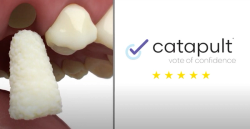- About Us
- Advertise
- Editorial
- Contact Us
- Terms and Conditions
- Privacy Policy
- Do Not Sell My Personal Information
© 2025 MJH Life Sciences™ and Dental Products Report. All rights reserved.
Custom calibration
Technology has advanced rapidly over the past 40 years. Today we equate new technologies with CAD/CAM advances, milling, wax printing, scanners and other digital equipment. The lab industry has even developed a new language for the computer age. Words like splines, collision lines, wall heights and many others are routine conversation in a growing number of labs.
Technology has advanced rapidly over the past 40 years. Today we equate new technologies with CAD/CAM advances, milling, wax printing, scanners and other digital equipment. The lab industry has even developed a new language for the computer age. Words like splines, collision lines, wall heights and many others are routine conversation in a growing number of labs.
What is less obvious-but as important-is the technological evolution of the porcelain furnace. Forty years ago we used analog furnaces with features such as a photo sensor temperature dial that was sensitive to light sources and would sometimes cause firing failures. The muffle designs and materials used for their manufacture were not of the quality we have in furnaces today. Porcelain furnaces give us accuracy and consistency in our porcelain that was unachievable with the furnaces of 40 years ago.
The Whip Mix Pro Press 200 is our laboratory’s furnace of choice because it is factory calibrated at three temperature levels using a second thermocouple and an Omega Meter.
In this article, I will demonstrate how to set up the firing programs once the ideal porcelain maturation is determined. Porcelain manufacturers’ firing charts are recommended starting points. Manufacturers advise that vitality, surface texture, surface shine and detail should be used to determine porcelain maturation. GC America states that these firing parameters only should be considered a guide. Other manufacturers have similar statements. For this reason, the porcelain furnace needs to be temperature-adjusted to compensate for the difference between what is simply a starting point and what is the desired maturation. Those parameters will be set in the furnace using a feature unique to the Pro 200 Furnace. I also will show how to synchronize the porcelain maturation and the temperature dial using the high or low fusing porcelain calibration feature (also unique to this furnace series).
Getting started
01 Porcelain tabs should be placed on a double honeycomb tray so as to fire in the same zone as porcelain every time. This is the calibration zone for the furnace. Note: there are other contributing factors that can affect porcelain firings, such as porcelain condensation, tray materials, vacuum, rate of climb, environmental conditions, etc., but for purposes of this article we will only focus on porcelain maturation. We use the GC porcelain system in our laboratory.
Currently we use the GC Titanium, MC (metal ceramic), ZR, and the IQ One Body systems. We will use clear windows for the titanium calibration, CLF for the MC, ZR, and IQ One Body shaded material.
Porcelain calibration
02 The shade tabs were fabricated using the dry powder technique with a tapered tab maker that measures 1 mm at the thinnest edge to 2 mm at the thickest point. Apply porcelain using the dry powder technique (Fig. A).
03 The fired tabs were placed adjacent to those that are fully matured (Fig. B). Notice the difference in porcelain vitality from left to right. The tabs in the first column on the left were fired according to the manufacturer’s firing chart temperatures. The other tabs are fired 50°C higher, to our desired porcelain maturation. Also notice the sharp 90° edge on the tabs as well as sharp details on the thin veneers of porcelain.
When determining the proper maturation, we are looking for vitality as well as sharp detail. If you lose detail in the tabs, reduce the temperature approximately 10°, fire another tab and reevaluate.
When properly fired, clear windows porcelain will let you read printed literature through it without the loss of sharp edges. CLF porcelains are not as transparent, but will still allow a diffused view of the printed literature.
calibration programming
04 The High Fusing or Low Fusing porcelain calibration screen is located under Special Functions (Fig, C). It allows a +/– 50°C adjustment. The adjustment is made after you determine the porcelain’s ideal porcelain maturation temperature. We determined the maturation we want is +50°C higher than the manufacturer’s recommended starting point. Therefore the High Fusing adjustment will be set +50°C. This provides the proper temperature offset so I can program and synchronize my readout screen with the porcelain manual’s firing chart.
05 Next I enter the data from the chart or in the Master Suite feature of the Pro 200 furnace. With the +50°C offset entered, the manufacturer’s temperatures will be entered to synchronize the calibration and the readout screen. I can program all of my data in my computer, download it to a memory stick and plug it into multiple furnaces. This enables me to control the furnace firing parameters in the lab.
Please note that titanium porcelains are low fusing, but the +50°C adjustment is made with the high fusing calibration parameters because the temperature adjustment exceeds the low fusing parameter of 805°C.
Custom firing calibration
06 We all want to fine tune different firing programs to achieve different levels of surface texture, sheen, and maybe even to raise or lower the glaze temperature for a specific account. You have the ability to customize each firing parameter to the desired temperature to achieve that result. There is a + or – 34°C available with this feature. This adjustment is found in each add/edit part of the program (Fig. D). Note that custom firing calibration is at the individual program level, enabling the ceramist to tweak each program individually. The 50°C offset adjustment affects all programs in that category of high fusing or low fusing porcelain.
Firing accuracy
07 We loaded a full tray to show accuracy of firings from the outer edge of the tray to the center (Fig E). The vitality is consistent and the 90° sharp edges remain on all tabs. Consistently accurate firings are clearly demonstrated.
08 We polished the tabs from Figure. E and placed them over dual broken black and white lines on the firing tray for the visual evaluation (Fig. F). Note the sharp edges, and the uniform clarity that is exhibited from the center to outer edges of the tray. The Whip Mix Pro 200 furnaces provide consistently accurate and uniform firing of porcelain.
You have to make the call
We test fired other high fusing porcelains in the Pro 200 furnace and found they also needed to be adjusted by baseline porcelain calibration before programming the furnace. We tested Creation, IPS d.Sign, Shofu, VITA and Noritake ceramic systems. I test fired 10 systems and found an average offset similar to the GC line of porcelain. Your baseline calibration may vary and that is expected because ultimately, porcelain maturation is a visual determination that each technician has to make. Consistency with our porcelain starts with understanding the ceramic system’s parameters and programming that information into our furnace.
This Pro 200 furnace is one of three Whip Mix furnaces in our lab. The program data is the same in all three. The features I discussed along with quality, customer service, warranty and price make this furnace ideal for any laboratory.



